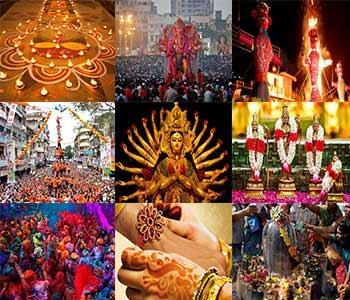Celebrating the Vibrant Tapestry of Hindu Festivals 🎉🕉️

Introduction:
Hinduism, one of the world's oldest religions, is rich in traditions, rituals, and festivals that celebrate various aspects of life, spirituality, and history. From the joyous colors of Holi to the divine chants of Navaratri, each festival in the Hindu calendar holds a special significance and is celebrated with fervor and devotion.
Sarasvati Puja: 📚🙏
Sarasvati Puja, usually celebrated in January, honors Goddess Saraswati, the embodiment of knowledge, music, and arts. Legend has it that Saraswati emerged from Lord Brahma's body, and the festival commemorates her divine presence. Devotees worship Saraswati seeking blessings for wisdom and learning.
Maha Shivaratri: 🕉️🌙
Maha Shivaratri, falling in February or March, reveres Lord Shiva, the cosmic dancer and destroyer of evil. It signifies the wedding of Shiva and Parvati and the cosmic dance of creation. Devotees observe fasts, perform rituals, and seek Lord Shiva's blessings for inner peace and spiritual enlightenment.
Holi: 🎨🔥
Holi, celebrated in March, is the festival of colors and joy. It commemorates the victory of good over evil and the arrival of spring. The legend of Prahlad and Narasimha, along with the playful antics of Lord Krishna, adds vibrancy to the festivities. People splash colors, dance, and indulge in festive delicacies.
Rama Navami: 🏹🌺
Rama Navami, in March or April, marks the birth of Lord Rama, the epitome of righteousness and virtue. Devotees rejoice in the glory of Rama's life, reciting verses from the Ramayana and offering prayers for prosperity and happiness.
Hanuman Jayanti: 🐒🙌
Hanuman Jayanti, celebrated in April, honors the birth of Lord Hanuman, the epitome of devotion and loyalty. Devotees chant hymns, recite Hanuman Chalisa, and seek his blessings for strength and courage.
RathaYatra: 🛕🎉
RathaYatra, typically celebrated in June or July, is the chariot festival dedicated to Lord Jagannatha. It commemorates his annual visit to the Gundicha Temple, accompanied by elaborate processions, devotional songs, and cultural performances.
Raksha Bandhana: 👫🎁
Raksha Bandhana, in August, celebrates the bond between brothers and sisters. Sisters tie rakhi on their brothers' wrists, symbolizing love and protection. Families come together to exchange gifts and blessings.
Janmashtami: 🍼👶
Janmashtami, in August or September, rejoices in the birth of Lord Krishna, the mischievous deity of love and compassion. Devotees fast, sing bhajans, and participate in midnight prayers to celebrate Krishna's divine incarnation.
Ganesh Chaturthi: 🐘🙏
Ganesh Chaturthi, in August or September, marks the birthday of Lord Ganesha, the remover of obstacles. Devotees install clay idols of Ganesha, offer prayers, and immerse the idols in water bodies, symbolizing the cycle of creation and dissolution.
Navaratri/Durga Puja: 🌺🗡️
Navaratri/Durga Puja, in September or October, celebrates the victory of Goddess Durga over the demon Mahishasura. Devotees worship the divine feminine energy, seeking protection and blessings for prosperity and well-being.
Dussehra (Dashain): 🏹🔥
Dussehra, celebrated in October, commemorates the triumph of Lord Rama over the demon king Ravana. Effigies of Ravana are burnt to symbolize the victory of good over evil.
Diwali (Dipawali): ✨🪔
Diwali, in October or November, is the Festival of Lights, symbolizing the triumph of light over darkness and good over evil. Homes are adorned with lamps, firecrackers light up the sky, and sweets are shared to spread joy and prosperity.
Conclusion:
Hindu festivals are not merely celebrations but a reflection of the profound spiritual heritage and cultural diversity of India. From the devotion of Saraswati Puja to the revelry of Holi and the grandeur of Diwali, each festival embodies the essence of Hinduism, fostering unity, harmony, and reverence for life.
Let's embrace the vibrant tapestry of Hindu festivals, cherishing the timeless traditions and values they impart to humanity. 🙏🌟
- Political Leaders
- Art & Crafts
- Dance & Music
- Sanatan Dharma
- Education & Training
- Food & Drinks
- Gaming
- Health & Fitness
- Home & Gardening
- Literature & Culture
- Love
- Medicine & Ayurveda
- Motors & Vehicles
- Movies & Cinema
- Parenting
- Politics
- Science & Technology
- Shopping
- Social Media
- Spirituality
- Sports
- War & History
- Yoga & Meditation
- Travel & Tourism
- Natural Disaster
- Business & Startups
- DIY & Home Decor
- Finance
- Personal
- News
- Pet Lovers
- Wild Life & Nature
- Podcast & Audio Books
- Poetry
- Law & Order
- Moral Stories
- Jokes & Humour
- Other

